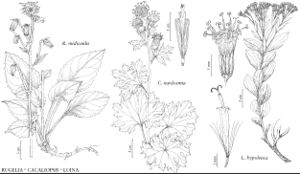Rugelia
Fl. S.E. U.S., 246. 1860.
| Taxon | Illustrator ⠉ | |
|---|---|---|
 | Rugelia nudicaulis Cacaliopsis nardosmia Luina hypoleuca | Yevonn Wilson-Ramsey Yevonn Wilson-Ramsey Linny Heagy |
Perennials, 20–40 (–50) cm (rhizomes creeping, roots fibrous, branched). Stems 1 (–3), erect (scapiform, sparsely arachnoid, unevenly glabrescent proximally, hirsute and/or stipitate-glandular distally). Leaves mostly basal (cauline smaller); alternate; petiolate (bases ± sheathing); blades palmately or palmati-pinnately nerved, ovate to nearly cordate, margins dentate to denticulate, abaxial faces tomentose to arachnose-villous, glabrescent or glabrate, adaxial puberulent or glabrate. Heads discoid (often ± nodding), in cymiform (terminal or axillary) arrays. Calyculi 0 or of 1–3 bractlets. Involucres cylindric or turbinate, 10–12+ mm diam. Phyllaries persistent, 10–15 in 1–2 series, erect (spreading in age), distinct, lance-linear to linear, equal, margins ± scarious (abaxial faces ± hirsute). Receptacles flat or convex, smooth or ± foveolate, epaleate. Ray-florets 0. Disc-florets 30–40 (–80+), bisexual, fertile; corollas usually ochroleucous or whitish, sometimes greenish, tubes shorter to longer than narrowly cylindric throats, lobes 5, erect or spreading, lanceolate to lance-linear; style-branches: stigmatic areas continuous or in 2 lines, apices truncate to rounded-truncate. Cypselae cylindro-fusiform, 20-nerved, glabrous; pappi persistent, of 80–120, whitish to stramineous, barbellulate to smooth bristles (equaling or surpassing involucres). x = 7.
Distribution
se United States
Discussion
Species 1.
Selected References
None.